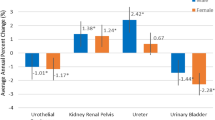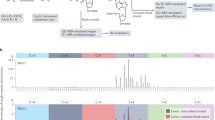Abstract
Purpose
The high incidence of upper urinary tract urothelial carcinoma (UTUC) in Taiwan is largely due to exposure to aristolochic acid (AA), a principal component of Aristolochia-based herbal medicines. Here we systematically review the molecular epidemiology, clinical presentation and biomarkers associated with AA-induced UTUC.
Methods
This is a narrative review. Medline, Embase, and Web of Science were searched from inception to December 31, 2021. Studies evaluating the association, detection, and clinical characteristics of AA and UTUC were included.
Results
A nationwide database revealed 39% of the Taiwanese population had been exposed to AA-containing herbs between 1997 and 2003. Epidemiological reports revealed AA posed a significantly higher hazard for renal failure and UTUC in herbalists and the general population who ingested AA-containing herbs. The presence of aristolactam-DNA adducts and a distinctive signature mutation, A:T to T:A transversions, located predominantly on the non-transcribed DNA strand, with a strong preference for deoxyadenosine in a consensus sequence (CAG), was observed in many UTUC patients. Clinically, AA-related UTUC patients were characterized by a younger age, female gender, impaired renal function and recurrence of contralateral UTUC. To date, there are no preventive measures, except prophylactic nephrectomy, for subjects at risk of AA nephropathy or AA-related UTUC.
Conclusion
AA exposure via Aristolochia-based herbal medicines is a problem throughout Taiwan, resulting in a high incidence of UTUC. Aristolactam-DNA adducts and a distinctive signature mutation, A:T to T:A transversions, can be used as biomarkers to identify AA-related UTUC. AA-related UTUC is associated with a high recurrence rate of contralateral UTUC.


Similar content being viewed by others
References
Ferlay J, Shen HR, Bray F, Forman D, Mathers C, Parkin DM (2008) Cancer incidence and mortality worldwide: IARC CancerBase No. 10
Chen CH, Dickman KG, Moriya M et al (2012) Aristolochic acid-associated urothelial cancer in Taiwan. Proc Natl Acad Sci USA 109:8241–8246
Bureau of Helath Promotion DoHT. The incidence of bladder, renal pelvic and ureteral tumor in Taiwan. https://cris.hpa.gov.tw/pagepub/Home.aspx?itemNo=cr.q.10. Accessed 24 Jan 2022
Howlader NNA, Krapcho M, Garshell J, Miller D, Altekruse SF, Kosary CL, Yu M, Ruhl J, Tatalovich Z, Mariotto A, Lewis DR, Chen HS, Feuer EJ, Cronin KA (eds) SEER cancer statistics review, 1975–2011, National Cancer Institute. Bethesda, MD, http://seer.cancer.gov/csr/1975_2011/. Based on November 2013 SEER data submission, posted to the SEER web site, April 2014. Accessed 24 Feb 2015
Chiou HY, Hsueh YM, Liaw KF et al (1995) Incidence of internal cancers and ingested inorganic arsenic: a seven-year follow-up study in Taiwan. Can Res 55:1296–1300
Bureau of Health Promotion T (2019) Adult smoking behavior surveillance system
Vanherweghem JL, Depierreux M, Tielemans C et al (1993) Rapidly progressive interstitial renal fibrosis in young women: association with slimming regimen including Chinese herbs. Lancet 341:387–391
But PPH (1993) Need for correct identification of herbs in herbal poisoning. Lancet 341:637
Nortier JL, Martinez MC, Schmeiser HH et al (2000) Urothelial carcinoma associated with the use of a Chinese herb (Aristolochia fangchi). N Engl J Med 342:1686–1692
Grollman AP, Shibutani S, Moriya M et al (2007) Aristolochic acid and the etiology of endemic (Balkan) nephropathy. Proc Natl Acad Sci USA 104:12129–12134
Hsieh SC, Lin IH, Tseng WL, Lee CH, Wang JD (2008) Prescription profile of potentially aristolochic acid containing Chinese herbal products: an analysis of National Health Insurance data in Taiwan between 1997 and 2003. Chin Med 3:13
Li SC (1578) Compendium of materia medica [Bencao Gangmu]
Anonymous (200) Shennong's compendium of materia medica [Shen Nong Ben Cao Jing]
Tao HJ (400) Annotated Shen Nong's Herbal [Bencaojing Jizhu]
Tong C (1999) Current status of misusage and replacement of Chinese herbs in Taiwan. J Chin Med 8:35–46
Chuang MS, Hsu YH, Chang HC, Lin JH, Liao CH (2001) Studies on adulteration and misusage of marketed akebiae caulis. Department of Health. Report No.: 20
Huang LH (2011) The current status and development of Chinese herbal industry in Taiwan. Taiwan
Health Do (2013) Statistics of National Health Insurance in Taiwan
Jong TT, Lee MR, Hsiao SS et al (2003) Analysis of aristolochic acid in nine sources of Xixin, a traditional Chinese medicine, by liquid chromatography/atmospheric pressure chemical ionization/tandem mass spectrometry. J Pharm Biomed Anal 33:831–837
Liu GM, Fang Q, Ma HS, Sun G, Wang XC (2013) Distinguishing characteristics of urothelial carcinoma in kidney transplant recipients between China and Western countries. Transpl Proc 45:2197–2202
Xiong G, Yao L, Hong P et al (2018) Aristolochic acid containing herbs induce gender-related oncological differences in upper tract urothelial carcinoma patients. Cancer Manag Res 10:6627–6639
Collins AJ, Foley RN, Herzog C et al (2011) US Renal Data System 2010 Annual Data Report. Am J Kidney Dis 57(A8):e1-526
Huang SJY, Chen HH (2000) Annual report of dialysis from 1999 to 2000 in Taiwan. Acta Nephrol 14:139–228
Yang CS, Lin CH, Chang SH, Hsu HC (2000) Rapidly progressive fibrosing interstitial nephritis associated with Chinese herbal drugs. Am J Kidney Dis 35:313–318
Chang CH, Wang YM, Yang AH, Chiang SS (2001) Rapidly progressive interstitial renal fibrosis associated with Chinese herbal medications. Am J Nephrol 21:441–448
Chen CH, Dickman KG, Huang CY et al (2013) Aristolochic acid-induced upper tract urothelial carcinoma in Taiwan: clinical characteristics and outcomes. Int J Cancer J Int Cancer 133:14–20
Yang HY, Wang JD, Lo TC, Chen PC (2011) Increased risks of upper tract urothelial carcinoma in male and female chinese herbalists. J Formosan Med Assoc Taiwan yi zhi 110:161–168
Yang HY, Wang JD, Lo TC, Chen PC (2013) Occupational exposure to herbs containing aristolochic acids increases the risk of urothelial carcinoma in Chinese herbalists. J Urol 189:48–52
Yang HY, Wang JD, Lo TC, Chen PC (2009) Increased mortality risk for cancers of the kidney and other urinary organs among Chinese herbalists. J Epidemiol Jpn Epidemiol Assoc 19:17–23
Lai MN, Lai JN, Chen PC, Hsieh SC, Hu FC, Wang JD (2010) Risks of kidney failure associated with consumption of herbal products containing Mu Tong or Fangchi: a population-based case-control study. Am J Kidney Dis 55:507–518
Lai MN, Wang SM, Chen PC, Chen YY, Wang JD (2010) Population-based case-control study of Chinese herbal products containing aristolochic acid and urinary tract cancer risk. J Natl Cancer Inst 102:179–186
Chang CH, Yang CM, Yang AH (2007) Renal diagnosis of chronic hemodialysis patients with urinary tract transitional cell carcinoma in Taiwan. Cancer 109:1487–1492
Hurst FP, Jindal RM, Fletcher JJ et al (2011) Incidence, predictors and associated outcomes of renal cell carcinoma in long-term dialysis patients. Urology 77:1271–1276
Wang SM, Lai MN, Chen PC, Wang JD (2015) Increased risk of urothelial cancer in young and middle aged patients with end-stage renal disease. J Formosan Med Assoc Taiwan yi zhi 114:52–57
Tai YS, Chen CH, Huang CY, Tai HC, Wang SM, Pu YS (2014) Diabetes mellitus with poor glycemic control increases bladder cancer recurrence risk in patients with upper urinary tract urothelial carcinoma. Diabetes/Metab Res Rev 31(3):307–314
Chung SD, Huang KH, Lai MK et al (2007) CKD as a risk factor for bladder recurrence after nephroureterectomy for upper urinary tract urothelial carcinoma. Am J Kidney Dis 50:743–753
Pfau W, Schmeiser HH, Wiessler M (1990) 32P-postlabelling analysis of the DNA adducts formed by aristolochic acid I and II. Carcinogenesis 11:1627–1633
Dong H, Suzuki N, Torres MC et al (2006) Quantitative determination of aristolochic acid-derived DNA adducts in rats using 32P-postlabeling/polyacrylamide gel electrophoresis analysis. Drug Metab Disposition Biol Fate Chem 34:1122–1127
Yun BH, Rosenquist TA, Nikolic J et al (2013) Human formalin-fixed paraffin-embedded tissues: an untapped specimen for biomonitoring of carcinogen DNA adducts by mass spectrometry. Anal Chem 85:4251–4258
Chen CH, Grollman AP, Huang CY et al (2021) Additive effects of arsenic and aristolochic acid in chemical carcinogenesis of upper urinary tract urothelium. Cancer Epidemiol Biomarkers Prev 30:317–325
Hoang ML, Chen CH, Chen PC et al (2016) Aristolochic acid in the etiology of renal cell carcinoma. Cancer Epidemiol Biomarkers Prev 25:1600–1608
Liu Z, Hergenhahn M, Schmeiser HH, Wogan GN, Hong A, Hollstein M (2004) Human tumor p53 mutations are selected for in mouse embryonic fibroblasts harboring a humanized p53 gene. Proc Natl Acad Sci USA 101:2963–2968
Mei N, Arlt VM, Phillips DH, Heflich RH, Chen T (2006) DNA adduct formation and mutation induction by aristolochic acid in rat kidney and liver. Mutat Res 602:83–91
Lord GM, Hollstein M, Arlt VM et al (2004) DNA adducts and p53 mutations in a patient with aristolochic acid-associated nephropathy. Am J Kidney Dis 43:e11–e17
Debelle FD, Vanherweghem JL, Nortier JL (2008) Aristolochic acid nephropathy: a worldwide problem. Kidney Int 74:158–169
Olivier M, Eeles R, Hollstein M, Khan MA, Harris CC, Hainaut P (2002) The IARC TP53 database: new online mutation analysis and recommendations to users. Hum Mutat 19:607–614
Hoang ML, Chen CH, Sidorenko VS et al (2013) Mutational signature of aristolochic acid exposure as revealed by whole-exome sequencing. Sci Transl Med 5:197ra02
Jelakovic B, Karanovic S, Vukovic-Lela I et al (2012) Aristolactam-DNA adducts are a biomarker of environmental exposure to aristolochic acid. Kidney Int 81:559–567
Schmeiser HH, Bieler CA, Wiessler M, van Ypersele de Strihou C, Cosyns JP (1996) Detection of DNA adducts formed by aristolochic acid in renal tissue from patients with Chinese herbs nephropathy. Cancer Res 56:2025–2028
Feldmeyer N, Schmeiser HH, Muehlbauer KR et al (2006) Further studies with a cell immortalization assay to investigate the mutation signature of aristolochic acid in human p53 sequences. Mutat Res 608:163–168
Moriya M, Slade N, Brdar B et al (2011) TP53 Mutational signature for aristolochic acid: an environmental carcinogen. Int J Cancer J Int Cancer 129:1532–1536
Cukuranovic R, Ignjatovic I, Visnjic M et al (2010) Characteristics of upper urothelial carcinoma in an area of Balkan endemic nephropathy in south Serbia. A fifty-year retrospective study. Tumori 96:674–679
Holmang S, Johansson SL (2006) Bilateral metachronous ureteral and renal pelvic carcinomas: incidence, clinical presentation, histopathology, treatment and outcome. J Urol 175:69–72 (discussion-3)
Huang PC, Huang CY, Huang SW et al (2006) High incidence of and risk factors for metachronous bilateral upper tract urothelial carcinoma in Taiwan. Int J Urol 13:864–869
Novara G, De Marco V, Dalpiaz O et al (2008) Independent predictors of metachronous bladder transitional cell carcinoma (TCC) after nephroureterectomy for TCC of the upper urinary tract. BJU Int 101:1368–1374
Yun BH, Rosenquist TA, Sidorenko V et al (2012) Biomonitoring of aristolactam-DNA adducts in human tissues using ultra-performance liquid chromatography/ion-trap mass spectrometry. Chem Res Toxicol 25:1119–1131
Krumbiegel G, Hallensleben J, Mennicke WH, Rittmann N, Roth HJ (1987) Studies on the metabolism of aristolochic acids I and II. Xenobiotica Fate Foreign Compounds Biol Syst 17:981–991
Fernando RC, Schmeiser HH, Nicklas W, Wiessler M (1992) Detection and quantitation of dG-AAI and dA-AAI adducts by 32P-postlabeling methods in urothelium and exfoliated cells in urine of rats treated with aristolochic acid I. Carcinogenesis 13:1835–1839
Springer SU, Chen CH, Rodriguez Pena MDC et al (2018) Non-invasive detection of urothelial cancer through the analysis of driver gene mutations and aneuploidy. Elife 7:e32143
Jhuang JR, Chiang CJ, Su SY, Yang YW, Lee WC (2019) Reduction in the incidence of urological cancers after the ban on chinese herbal products containing aristolochic acid: an interrupted time-series analysis. Sci Rep 9:19860
Author information
Authors and Affiliations
Contributions
KGD: project development, data analysis, manuscript writing. CHC: project development, data collection, data analysis, manuscript writing. APG: project development, manuscript editing. YSP: project development, manuscript editing.
Corresponding author
Ethics declarations
Conflicts of interest
All authors declared no conflicts of interest.
Research involving human participants and animals
Not applicable. In this article, we systemically reviewed the published studies associated with aristolochic acid and did not reveal new information obtained from human or animal studies.
Informed consent
Not applicable. This review article does not involve new human studies.
Additional information
Publisher's Note
Springer Nature remains neutral with regard to jurisdictional claims in published maps and institutional affiliations.
Rights and permissions
About this article
Cite this article
Dickman, K.G., Chen, CH., Grollman, A.P. et al. Aristolochic acid-containing Chinese herbal medicine and upper urinary tract urothelial carcinoma in Taiwan: a narrative review. World J Urol 41, 899–907 (2023). https://doi.org/10.1007/s00345-022-04100-5
Received:
Accepted:
Published:
Issue Date:
DOI: https://doi.org/10.1007/s00345-022-04100-5




